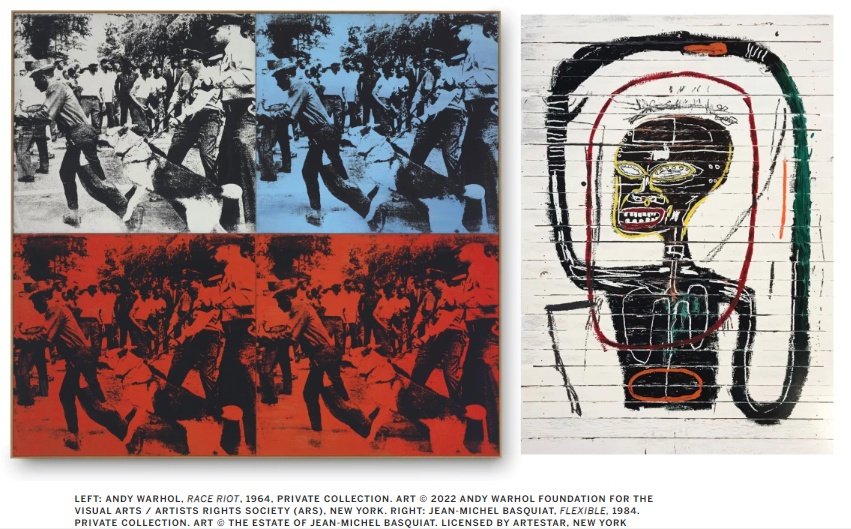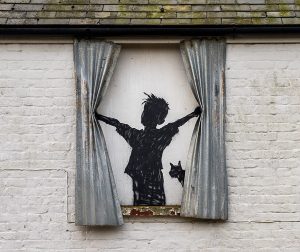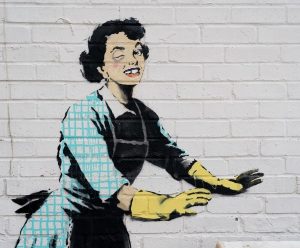
Choose Your Weapon, 2009
Spray-paint and emulsion on board, in two parts
237 x 244.3 cm (93 1/4 x 96 1/8 inches)
Unique
Signed and dated ‘Banksy 09’, on the reverse
Sotheby’s New-York: 19 May 2022
Source: Sotheby’s
One of the most enigmatic images of Banksy’s famously provocative oeuvre, the iconic image of an ominously masked and hooded young man walking Keith Haring’s cartoon dog with a metal chain is both a political commentary on the rising violence among youth in England and an ode to the power of street art as a means of resistance. The story behind the mysterious emergence of Choose Your Weapon perfectly captures the central paradoxes of Banksy’s legendary status as both notorious vandal and venerated artist: after debuting overnight in 2010 on the walls of a bar in the South London Borough of Southwark, the present work was promptly boarded over to conceal its ominous image. Yet it was recovered only shortly thereafter, this time reappearing beneath Perspex glazing affixed by loyal Banksy supporters to protect the image from defacement. The present work is the only material reproduction of the original graffiti left on the Southwark street, aside from the limited edition of prints that Banksy released of the image. While the scene in Choose Your Weapon references the menacing pitbulls and terriers trained by British youth gangs to attack others – a criminal phenomenon widely discussed by national media in the early 2010s – Banksy tactfully subsumes the belligerence normally evoked by these “weapon dogs” with his immediate recollection of Keith Haring’s joyfully politicized street art as the “weapon” in question.

Entitled to reference the classic aphorism “the pen is mightier than the sword,” Choose Your Weapon reflects Banksy’s own unequivocal relationship with street art: to him, the spray can is even mightier than the pen, and graffiti is his ultimate weapon against senseless violence and injustice in society. Moreover, its title decidedly written in second person, Choose Your Weapon turns the biting critique that Banksy traditionally reserves for authority into a direct confrontation of his audience here, implicating a moment of critical self-reflection as he asks us to consider: what is our weapon of choice, and what ought we use it to fight against?
Banksy first came to public attention in the early 2000s with a renegade form of street art that looked to challenge the social order by which we live. Serving pithy social commentary via lightning-quick, dark-humored punchlines, Banksy rapidly became immensely popular with a broad cultural base. Banksy has outlined his own mission with the adage “Art should comfort the disturbed and disturb the comfortable,” a modern day take on the turn-of-the-century American satirist Finley Peter Dunne’s declaration that the duty of a newspaper is to “comfort the afflicted and afflict the comfortable.” (Finley Peter Dunne quoted in: Dean P. Turnbloom, Ed., Prizewinning Political Cartoons: 2010 Edition, Gretna 2010, p. 146) In the tradition of satirist painters Honoré Daumier and William Hogarth before him, Banksy uses the power of familiar symbols juxtaposed with incompatible references to create absurd and provocative images that convey potent political messages. In line with his staunch anti-establishmentarian philosophy, early graffiti stencils leading up to Banksy’s most iconic works like Love is in the Air, where his protagonists throw flowers instead of grenades, trace the artist’s ideological opposition against the abuse of weaponized power, which has remained core to his tongue-in-cheek lampoon of society since the onset of his career. A consistent opponent of brute violence and insidious corruption, Banksy disrupts the normalcy of everyday public life to both call for change and advocate for peace with galvanizing political force.

By the mid-2000s, Banksy’s work began to veer increasingly towards more traditional artworld territories. Losing none of his satirical bent, his foray into the artworld establishment was to remain just as dissident and subversive, operating on paradoxical levels that further served to heighten the underlying political and satirical impetus of his art. In Choose Your Weapon, Banksy expresses his alliance with the guerilla outsiders of art history by paying tribute to Keith Haring, the rebellious pioneer of street art who belonged to an alternative community of artists like Kenny Scharf and Jean-Michel Basquiat that burgeoned outside the high-brow art world of galleries and museums. Roaming the downtown streets, underground subway system, and nightclubs of New York City throughout the 1980s instead, Haring championed an accessible and trademark style of street art that publicly addressed social issues ranging from drug abuse to the threat of nuclear apocalypse through his electrifying pop-graffiti aesthetic. Working at the same time to disrupt the New York art scene was Basquiat, Haring’s close friend, who similarly turned to graffiti to explicitly express his disavowals of racism, class, and government under the mysterious pseudonym SAMO, shorthand for “same old crap.” Like his street art forebears, Banksy has debuted paintings and sculptures on platforms that utterly defy the traditional artist/gallery model via the handful of exhibition projects that comprise his back catalogue of solo shows – beginning in 2003 with Turf-War, then the 2005 Crude Oils, Barely Legal in 2006, his takeover of the Bristol Museum in 2009, and the pop-up “bemusement park” Dismaland in 2015. From vandalized warehouses to an apocalyptic theme park, Banksy has established himself as the preeminent contemporary successor to the subversive traditions of street art as his strikingly cryptic images combine the absurd jadedness of Basquiat’s SAMO and the political activism behind Haring’s graffiti icons to hold up an unforgiving mirror towards contemporary society.

Banksy’s Choose Your Weapon emerged during a moment of rising public and media concern in Britain over the appearance of belligerent dogs associated with urban youth gangs. In November 2009, one year prior to the sudden appearance of Choose Your Weapon, the Greater London Authority had issued a report to warn the public about the rising domestication of “weapon dogs” by youth gangsters as threatening tools of intimidation and violence. Rather than outrightly critiquing the troubled youth in the present work, Banksy seems to empathize with their angst, seemingly placing himself in the position of the hooded figure who is disguised to conceal his identity as the graffiti artist himself would when creating his street works. Directing a critical commentary toward the broader power structures that have resulted in the disgruntlement of youth in his native country, Banksy succinctly addresses this criminal phenomenon in his purposeful appropriation of Haring’s barking dog, which herein serves as a symbol of both the increasing militancy amongst British gang members and the legacy of politicized street art that Haring posthumously left behind. Tightly leashed to a metal chain, the dog belies its beloved reputation as “man’s best friend” as it seems to make the abrupt transition into the incognito’s man weapon, but its unmistakable reference to Haring lends itself to ultimately prevail as a symbol of hope and the defiance of pre-existing authoritarian structures through creative expression.

Gang Members in London, 2011
Photo: Josh Cole
Though removed from its original guerrilla iteration on the local streets of London since 2016, Choose your Weapon testifies to Banksy’s unique ability to activate urban environments in ways that supercharge his message, lending his images a searing immediacy for all those who live in or visit the region. In its political potency and use of a found-industrial material as the painting’s ground, the present work reminds us of the central paradoxes that construe Banksy’s career: at once poignant and pun-fueled, he toes the line between vandal and creator, creating works of acerbic impact that advocate for the marginalized in society. Simultaneously at the center of the art world and decidedly outside it, Banksy is at once one of the most famous artists working today and an anonymous outsider. Like Love is in the Air and Girl with Balloon, other iconic stencils that exemplify Banksy’s captivating graffiti technique and social commentary, Choose Your Weapon ultimately offers a resounding message of hope in its striking invocation of youth. As the anonymous hooded youngster walks Haring’s barking dog, he is simultaneously led by it, too, affirming the revolutionary power for change within the street art tradition that Banksy indisputably commands today.





 Gang Members in London, 2011
Gang Members in London, 2011


